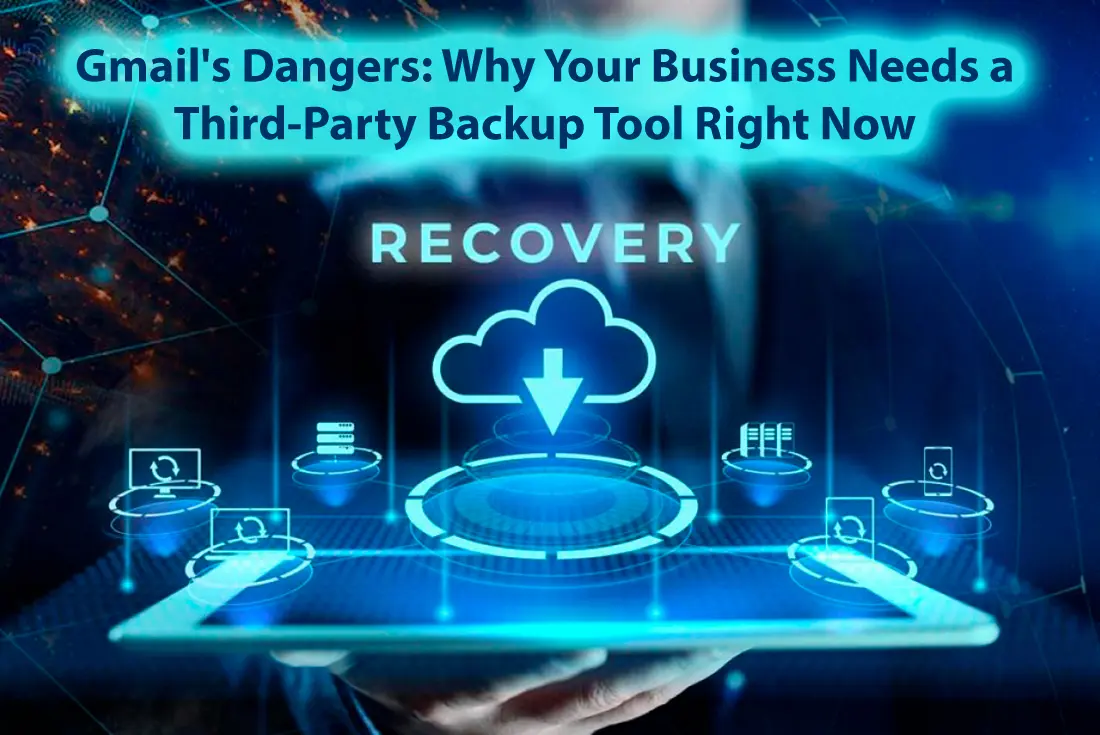
24 May Gmail’s Dangers: Why Your Business Needs a Third-Party Backup Tool Right Now
Today, there are countless ways to communicate. Businesses use messengers, social media, and good old phone communication. However, email remains a critical tool for businesses. And Gmail is a popular choice due to its reliability and extensive features, including data retention with Google Vault’s help.
While Google takes steps to secure its infrastructure, you’re ultimately responsible for safeguarding your own emails. From accidental deletions that can wipe out years of correspondence to cyberattacks that could cripple your operations, the threats are real. Keep reading to discover the limitations of Google’s native data recovery and backup tools and learn why third-party backup software is your best defense against losing invaluable business information.
Google’s Responsibility for Gmail Data Safety
Before we get into the details, let’s answer the big question: Is Google responsible for your data? Well, Google takes measures to safeguard Gmail data. They offer two-factor authentication to protect your account, plus TLS and S/MIME encryption protocols to ensure data security. However, it’s important to note that Google operates under a shared responsibility model when it comes to data protection.
Shared responsibility means that Google is liable for securing only their infrastructure—the hardware and software that underpin cloud-based services. This is about the physical security of the data centers, network security, and protection against internal and external threats. Data management and protection within your Gmail account, including backup, is fully on your shoulders.
At the same time, backup is a necessity since losing data is easy. Now, let’s discuss two main reasons why you might lose your Gmail data and then explore why you need third-party IT security solutions—backup software.
Why You Might Lose Important Emails
Although Google safeguards Gmail accounts, it cannot be said that you are completely protected from hacking. Gmail’s security measures, such as strong passwords, two-factor authentication, spam filters and phishing protections, are robust but not foolproof. Users still face risks from phishing attacks, malware, and other cyber threats. Once cybercriminals gain access, they can delete emails, change account settings, lock users out of their accounts, or even delete accounts together with all data.
Another way businesses can lose important emails is accidental deletion. Sometimes, employees delete them while organizing their inboxes or during mass deletions. They may also mistakenly delete important emails when clearing out spam or irrelevant messages. This is common, especially in teams where efficiency is critical and people are always in a rush.
In both cases, you can recover your data if you have backups. If an account is hacked, you can swiftly restore lost or altered emails from the separate, secure backup. If an employee accidentally deletes important emails, you can also rely on backup. But unfortunately, with native tools from Google, backup and data recovery are not easy tasks.
Gmail Recovery Limits
Gmail offers recovery options for deleted emails, but they have limitations. When you delete an email, it moves to the Trash folder, where it stays for 30 days. Once the 30-day window closes, Gmail permanently deletes the email, making it irrecoverable for a user. Also, if an email is permanently deleted from the Trash before the 30 days are up, there’s no way the user can recover it.
However, for Google Workspace accounts, administrators have the capability to recover deleted emails through the Google Admin Console. Even after 30 days, they can restore permanently deleted emails from Gmail, but only within a 25-day window after the initial 30-day period.
As for the Google Vault, which many mistakenly consider a data recovery and backup tool, its purpose is the eDiscovery and investigation. Specifically, it allows you to set retention rules that organize how data is stored and for how long and purge data once it’s no longer needed. Google Vault doesn’t replicate data for later recovery or have any backup software functionality.
However, it’s important to know, that even when a retention rule is set to purge data, Google Vault still gives you around 30 days for data recovery before it is fully purged. At the same time, an improperly set up retention rule might allow Vault to immediately and irreversibly purge data, Google warns.
No Native Backup Tools
Long story short, if you need to back up your Gmail, you have only one native tool — Google Takeout. Yes, it’s primarily designed for exporting data from various Google products, not backup. However, you can use it to download your Gmail data in MBOX and JSON formats and then save it somewhere safe. It also offers simple automation — you can enable data download every two months throughout the year. This is where the functionality of the Google Takeout ends. If you need more frequent and flexible backup routines to ensure data integrity and security, then this tool won’t help you.
Third-Party Backup Software: Your Gmail Guardian Angel
The limitations of Google’s native tools highlight the need for a more robust solution to safeguard your Gmail data. This is where IT security solutions, represented by a third-party backup tool, step in to save the day, offering comprehensive protection and peace of mind that Google alone cannot provide. At Downtown Computer Services, we’ll install reliable software, monitor the backup process to cloud-backed services, and test data recovery to make sure everything works correctly. Call us now at (954) 524 9002 to protect your business.
Here’s what backup software will bring you:
No More Accidental Deletion Worries
Unlike Gmail’s limited recovery window, which only lasts 30 days in the Trash folder and an additional 25 days for Google Workspace admins, the third-party backup tool keeps a separate, secure copy of your emails indefinitely. This means you can recover emails that were deleted months or even years ago. Whether you mistakenly deleted an important client email or accidentally emptied your Trash, your data is safe and retrievable.
Outsmarting Cybercriminals
Hackers are constantly evolving their tactics, making it difficult for even the most secure platforms to remain immune. When your Gmail account falls victim to a cyberattack, the consequences can be devastating, including the loss of sensitive business information, financial data, and even customer trust. Third-party backups act as your safety net, allowing you to restore your emails to a point before the attack, minimizing the damage and ensuring business continuity.
Customizable Backup Routines
Don’t settle for Google Takeout’s limited backup options, which only allow for automatic downloads every two months. Third-party tools let you set up backups on your schedule, whether it’s daily, weekly, or even hourly. This ensures your data is always up-to-date and protected, reducing the risk of losing valuable information between backups.
Fine-Tuned Control and Recovery
While Google Vault boasts impressive retention capabilities (up to 36500 days), it can’t offer the flexibility and granularity that some businesses require. It also disappoints with a 30-days recovery window before data is fully purged. The third-party backup tool provides more fine-tuned control over retention policies, allowing you to set different retention periods for different types of emails or users. Additionally, it offers more powerful, streamlined and user-friendly recovery processes, making it easier to restore individual emails or entire folders without the need for complex exports and manual reintegration.
Say Goodbye to Recovery Headaches
Unlike the complex and time-consuming process of restoring emails from Google Vault, third-party backup solutions come with user-friendly interfaces and simple recovery processes. You don’t need to be a tech expert to restore your emails; it’s as easy as a few clicks, saving you valuable time and resources.
Extra Protection, Just in Case
Many third-party tools go beyond basic backup and recovery. They offer features like encryption, which ensures your data is unreadable to unauthorized parties; versioning, which lets you roll back to previous versions of emails; and even ransomware protection, which safeguards your data from malicious attacks. These additional layers of security provide comprehensive protection for your Gmail data, giving you peace of mind.
Conclusion
Gmail is indispensable for modern businesses, but relying solely on Google’s native tools for data protection leaves your critical information vulnerable. From accidental deletions to cyberattacks, the risks are real, and the limitations of Gmail’s recovery and backup options leave you scrambling to recover lost data.
Third-party backup solutions offer a comprehensive and reliable way to safeguard your Gmail data. They provide robust recovery options, customizable backup routines, fine-tuned control over retention policies, and additional security features that go beyond what Google offers. By investing in a third-party backup solution, you’re not just protecting your emails – you’re safeguarding your business’s future.
If you are ready to protect your Gmail data with third-party backup software, contact Downtown Computer Services today at (954) 524 9002.
Key Takeaways
- Google’s shared responsibility model means they protect their infrastructure, but you’re ultimately responsible for safeguarding your Gmail data.
- Gmail’s native recovery and backup options are limited and may not be sufficient to fully protect your business from data loss due to accidental deletion or cyberattacks.
- Third-party backup solutions offer comprehensive protection, customizable features, and peace of mind by ensuring your Gmail data is secure and easily recoverable.
Check out other relevant news
- How Easy-to-Use Hacking Tools Are Fueling Cybercrime
- Cryptocurrency Security for Small Businesses: Protecting Your Wallet
- The Infostealer Epidemic: Protecting Your Business from the Latest Wave of Cyberattacks
- The Identity Crisis: How Compromised Credentials Can Cripple Your Business
- Beyond the Brick and Mortar: Building Your Online Storefront with Digital Marketing
